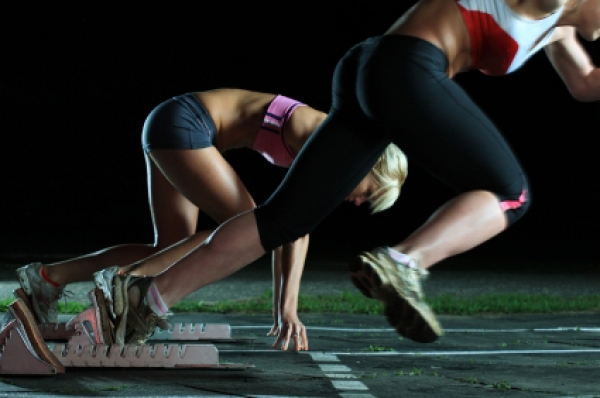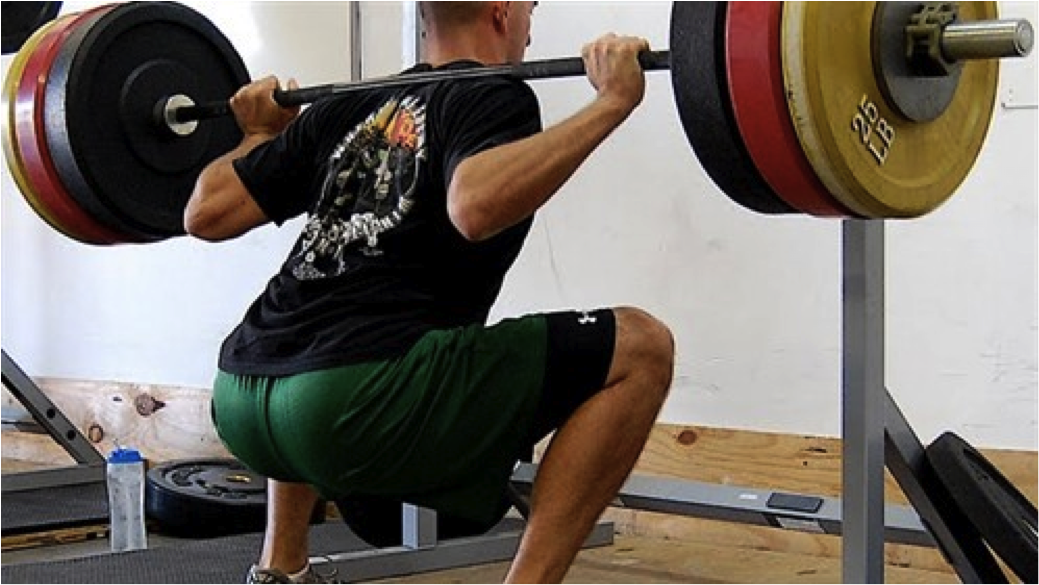In my youth I loved to sprint. (Heck, I enjoy it even as a grownup.)
Well, that’s not exactly true; what I really like is running past people.
Not that I go around sprinting past people in the mall, on the street, or even on the track. No, no, I like to sprint past people when I play soccer, basketball or Ultimate Frisbee.
I can’t explain why, but it makes me very happy to be able to sprint past someone trying really hard to stay in front of me.
So I spent much of my youth trying get faster. Too bad I didn’t read more studies back then. I could have saved myself some time and money.

Research question
This week’s review examines a study that explores how sprinting and squat strength are related.
This is not the first study to do something like this. One study found no correlation with sprint times and (10 & 40 metre) and machine squats (1).
But they didn’t examine real-world squats… y’know, the kind with a barbell.
Another found no correlation with isometric (static) peak force of single joint strength — knee extensors (primarily quads), hip extensors (primarily glutes and hamstrings), hip flexors (primarily hip flexors) — and sprint times (2).
But they didn’t examine multi-joint movements — exercises with more than one moving part.
So all we know is that some lab conditions have no relationship to sprints. Well, neither of these reflect how sprinters actually train: with free weights and complex movements, such as barbell back squats, jump squats, power cleans, and such.
Thus, this group decide to try testing free weight exercises instead of machine exercises and multiple joint strength instead of single joint strength. Researchers compared free weight squat performance to sprint times.
Before I get into the study there is one HUGE assumption that the authors have made and so far I’m playing along – see if you can figure it out before the end of the review.
McBride JM, Blow D, Kirby TJ, Haines TL, Dayne AM, Triplett NT. Relationship between maximal squat strength and five, ten, and forty yard sprint times. J Strength Cond Res. 2009 Sep;23(6):1633-6.
Methods
The participants in this study are unique in that they aren’t untrained. It’s much easier to find untrained participants for studies than trained ones.
Not only are these participants trained, they’re pretty damn elite. They’re Division I-AA (American) football players (17 players to be exact).
These participants have weight training experience and also compete in a sport that requires a certain amount of sprint speed (depending on their position) – both important points if you want to figure out whether squat strength is correlated to sprint times.
Table 1 – Summary of the average measures of the participants.
| Height (meters) | Weight (kg) | BMI (kg/m2) | 1 RM (Squat – kg) | 1 RM/ body mass ratio* |
|---|---|---|---|---|
| 1.78±0.04 (5’10” ±1.6”) |
85.9±8.8 (189.4lb±19.4lb) | 27.0±2.6 | 166.5±34.1 (367.1lb±75.2lb) |
1.94±0.33 |
*Note: Just for reference here’s video of our own Krista Schaus squatting 156.5kg (345lb) at a body weight of 60.3kg (133lb) — a 1 rep max/body mass ratio of 2.6!
As I mentioned in the intro there have been studies that looked at squat strength and sprint times, but none of them looked at different distances. With this study they looked at 3 different distances (5 yards, 10 yards and 40 yards) and compared them to free squat 1 RM.
1 rep max squat testing
Before jumping into the squat 1 rep max the participants did a warm up. The warm up was 8-10 reps at 30% RM (based on a guesstimate), 4-6 reps at 50% RM, 2-4 reps at 70% RM and 1 rep at 90% RM.
Note: Unless you want to get really messed up you too should warm up, especially if you are going to try for your 1 RM.
Another important point about the 1 rep max squats is how low they squatted. For years there has been dogma that you shouldn’t squat below parallel (or 90 degree knee angle), because you can injure yourself.
Well, I say hooey! In the near future, I’ll review an article to support my assertion of hooeyness. Besides, have you watched Olympic lifters? They typically squat so deep that their hamstrings touch their calves.
For this study the footballers squatted to 70 degree knee angle – yes, below parallel! The researchers were anal enough to use a goniometer (from two Greek words gonia – angle and metron – measure) to measure their knee angle.
And to make sure they got as close to their 1 RM they were given up to 4 max tries with 3-5 minutes between tries.

Sprinting
Sprint testing was straight forward – participants started in a 3-point stance, started whenever they wanted (a touch sensitive pad detected when they started), ran as fast as they could for 40 yards with sprint times measured by infared at 5 yards, 10 yards and at the finish (40 yards).
Results
There is indeed a correlation between 1 RM squat strength and sprinnt time – with some qualifications.
- 1 RM squat strength was corrected using body mass (1RM/body mass ratio)
- 1 RM/body mass correlates to 10 and 40 yard sprint time, but not so much for 5 yards (more on that in a bit)
1 RM/body mass and sprint times
Why correct for body mass?
Well, sprinting is a dependent on body mass: the more mass you have, the more force you require to accelerate to a given speed (the good old physics equation of Force=mass X acceleration or acceleration = force/mass).
In order to sprint, you need to accelerate to a particular speed, and that requires the most energy.
“Get the ball rolling” isn’t just an expression — it sums up the concept of having to exert some energy in order to get something moving. Keeping the ball rolling is easier.
Or if you don’t believe in physics that you can do this simple experiment: time yourself sprinting as fast as you can for 40 yards, then after a good break put on a 20 lb weighted vest and try again. Were you faster with or without the vest? The answer is obvious.
So in this study, using a ratio of squat 1 RM to body mass is important for the analysis.
Why does 1RM/body mass correlate to 10 and 40 yard, but not 5 yards?
The researchers found that 1RM squat/body mass correlated to 10 and 40 yard sprint times (the higher the ratio the faster the times), but not 5 yard sprint times.
How is that possible? If you’re faster you’re faster, right? The most likely explanation is that 5 yards isn’t enough time to see a difference.
I am holding a little piece of information back – at the 5 yard mark there was no statistical difference, but there was a difference.
In stats the magic (and arbitrary) number for statistical differences is 5% (p=0.05; p meaning probability) or less. This means that there is a 5% (or less) chance (probability) that the difference seen is a cosmic fluke or taken another way – it’s 95% chance (probability) that this difference is real.
In the case of the 5 yard sprint times probability was 6.98% that the differences were a fluke and since it’s above the magic 5% it’s considered statistically not different, but I argue is likely a real world difference.
If you’re faster at 40 and 10 yards then you’re faster at 5 yards, but the difference is going to be smaller because you have less space to make up any time differences.
Over and under 2.0 1RM/body mass
The researchers split the footballers up into two groups and compared their sprint times. The two groups were:
- 1RM/body mass ratios over 2.1
- 1RM/body mass ratios under 1.9
And lo and behold the group with ratios over 2.1 — in other words, those who squatted more relative to their body mass — were faster at 10 and 40 yards compared to the group that had ratios below 1.9. Again the 5 yard mark showed no difference for much the same reason as before.
Conclusion
Squat 1 RM, when corrected for body mass, correlates with faster times at 40 yards, 10 yards and most likely 5 yards (in the real world, while not statistically).
If you have a 1 RM to body mass ratio more than 2.1 chances are you going to be faster than someone with 1.9.
So increasing your 1 RM squat improves sprint performance, right? Maybe. This is the HUGE assumption I mention in the intro – correlation does not mean cause and effect.
Yes, this study shows a correlation, but that doesn’t prove that increasing squat strength would improve sprint performance. It could be that people that are the fastest just happen to be the strongest.
This study is suggestive but not definitive — it provides clues but not proof.
To prove that increasing squat strength makes people faster you would need to design a study that looked at improvements in a person.
What would this look like? Well, you would want to randomly select people (ranging from weak to strong and slow to fast), then put them in a training program to increase squat strength.
You would also test their sprint time before and after the training program.
If there is a correlation between improvement in squat strength and an improvement in sprint times then you can say increasing squat strength improves sprint times.
Bottom line
There are lots of benefits to having a strong squat.
If you want to be faster, increasing your free squat 1 RM to 70 degree knee bend is a good bet, but remember this study doesn’t actually have any proof that increasing your squat strength improve sprint performance – just that individuals that could squat more could.
Learn more
Want to get in the best shape of your life, and stay that way for good? Check out the following 5-day body transformation courses.
The best part? They're totally free.
To check out the free courses, just click one of the links below.




Share